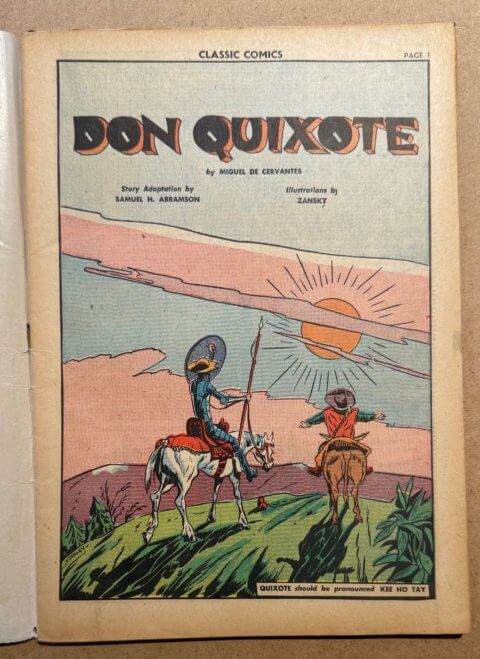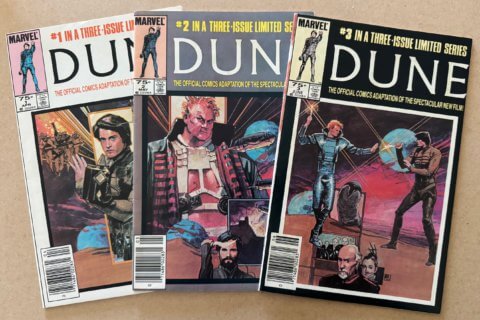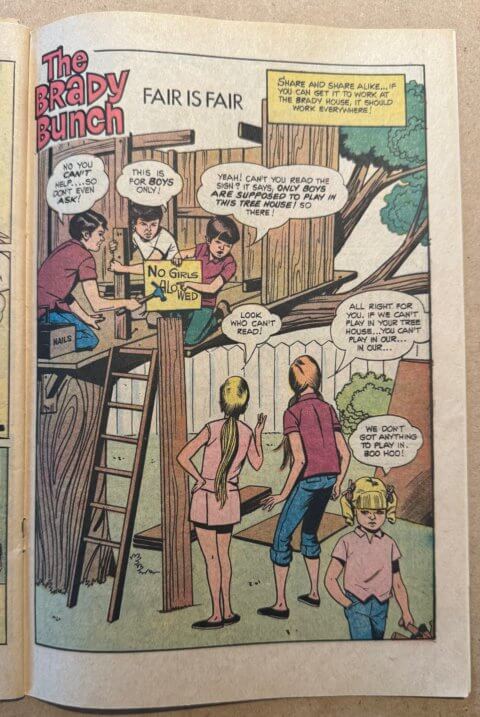
It used to be that a purple label (the colour of the label CGC gives to comics designated as restored) was the kiss of death for a comic book’s value. I remember when guys would see a purple label and lose interest in the book right away. I don’t think they even registered what book it was: purple label equals I don’t want it was their attitude. But all books are not restored the same, some have a tiny smudge of colour added to a cover while others are practically rebuilt.
About 5 years ago CGC introduced their tiered rating system for restored comic books. Its a pretty good system giving the restoration work three levels of quality: A, B and C, with A being the best pro-level work, CGC also assigned the amount of work put into a book with 1 being slight and going up to 5 which meant extensive. Obviously you want to own an A1 and avoid the C5. Or does it matter? Do these new tiers flush out different levels of value when the restored books go to market?
Let me interject here quickly, I will not be discussing CGC Conserved designations, we will leave that for another day.
What if the book was not unrestorable? What if that colour added on the A1 comic couldn’t safely be removed to get a blue unrestored label? Would it matter for value then? I mean purple is purple right?
There is a huge, ever-changing and very complicated marketplace for restored comic books. Let’s set aside the restored books bought with the hopes of them getting unrestored. let’s focus on books that are restored and will stay restored: how should we be looking at these books?
We’ve all see the huge run-up in value of ultra low-grade keys issued over the past decade. A CGC 0.5 Amazing Fantasy #15 blue label was fetching north of $9,000 for a while there; this was the price to join the club. I recently sold a CGC 3.5 Restored C-1 Amazing Fantasy #15 for just shy of $10,000. My copy looked way better than the dog’s breakfast CGC 0.5 that went for the same money. Wouldn’t you rather have a solid looking copy with a bit of marker added to the cover than a copy that looks like it just went through the laundry?
Actually, in the lower grades, the disparity isn’t that severe. low grade restored copies do get less than unrestored copies in the same grade, averaging somewhere in between 70% to 80% for key issues below the 2.0 grade (very unscientific figures but values I have mentally noted in the past), things get bad in the higher graded though where restored values can be 10% of the unrestored values. This sliding scale does make sense as the scarcity of a high-grade unrestored copy have a lot of demand.
Will the stigma of restoration fade over time? I think it has to a degree already but has farther to go. Fun fact: there are more restored copies of Detective Comics #27 out there (36) than there are unrestored copies (32). Detective Comics #27 with its first appearance of the Batman is one of the true holy grails of comic collecting; would you say no to a restored copy if that was your only option to own one?
I know that original paintings are one-off works of art but the art collecting world does not seem too bothered by restoration done to some of the old masterpieces. Paper rots and fades and crumples and moulds over time, restoration and preservation are important tools in keeping these treasures with us into the future.
My question is whether we’ve adapted to the new CGC restoration guidelines? Have we been reading the level or restoration designations and have we been assigning values in levels with the degrees of restoration or have we still been grouping these books into one big restoration bin?
Is the purple label the culprit? Should CGC go to their standard blue label but emphasize the restoration with bold letters and symbols?
Are restored books bargains now and should we be looking to stake our claim in a few in anticipation of more general market acceptance in the future?
I’d be willing to, but in the shallow end of the pool: I’d go for a solid CGC 3.0 restored copy but the book has to be very rare to begin with. No use having a restored Bronze Age book with plenty of unrestored supply.




Interesting as I was looking at a restored All American and wondering if it was worth bidding on a restored copy. I also didn’t understand the numerical designation on the restored copy. Is a 5.5 restored a 5.5 just among restored copies or does the restoration pull it up to a 5.5 grade… very confusing. I know from reading CBD for several years the purple label is to be shunned…or is on certain books…but I’ll tell you…looking back at that All American today…its really taking off!
I recall the 1980’s and 1990’s it was all the rage to restore any key book professionally. It was encouraged, just look at the ads in the Comic book price guide or comic related mags and newspapers of the time period. It seems wrong to punish what once was encouraged by the people and subject matter experts of the industry. And yet, reward comics with scotch tape on their spine or covers, oozing degraded glue, to be graded with a blue label. Disgusting, as scotch tape is amateur restoration at its worst. Worse in my mind then color touch ups
Following up on Dave’s comments… I have seen graded purple copies stating amateur restoration having tape and glue and then lower graded copies with blue labels with the same conditions. Is this because of when they were graded or does it have to do with the amount paid CGC?
I don’t know anything about CGC, so I can’t commrnt. My question is what is the difference between restored and qualified grades?
I’ve seen cases where “Glue on Cover” passes as Blue Label and on other books it gets a Purple Label, I’m not sure of what the guidelines are there Gerald of if it just inconsistency.
Klaus, a Qualified Label could be something like a missing page or a missing coupon in the book.
Dave, you are right, back in the day comic book celebrities were people like Susan Chiconi who restored books.
The issue of blue vs purple is primarily about money, especially if the purple is based on “slight” colour touch. If you’re a collector looking to build a high grade run, you can save mega bucks by seeking out 9.2 – 9.6’s with slight colour touch.
You are right Charlie a CGC 9.2 purple with Slight Color Touch may be the way to go.
Walt, I think this topic is worthy of continued discussion similar to Overstreet’s commentaries – an annual revisiting of how the sands have shifted.
First off, I am a “purple move on” guy. This is simply about liquidity, a chicken-and-egg thing. Like collecting bits of newsprint, this approach isn’t based on any “fundamental valuation”, but on the way I see others react. (The hobby on the high end is a Keynesian beauty contest.) I don’t want to hold something that is going to be that more difficult to sell in a pinch. Personally I am indifferent to restoration – in some ways I am indifferent to even owning a particular comic – but this is a game in which you guess what others will find valuable.
I think the tiered rating system can be useful if you can crack the book out, alter it somehow, and resubmit for a Universal rating. For example, buy a “Restored” book with some color touch on the corner, and cut off the corner. Yes you will get a lower grade, but as Restored books typically price at at least half and usually a third of what a Universal will, this could work well, especially for lower grade copies. (I haven’t tried this but it seems possible, to your point about “safe” removal.) Otherwise I don’t think it is that meaningful, so the answer to your later question is by and large no, people aren’t distinguishing. However there seems to be a big bias against trimmed copies. I personally can’t understand this either but whatever.
I would dispute your 70% to 80% below 2.0, but we need data before we duke it out, and given my argument above this could make sense. This might be true for uber-keys like AF #15 and Action #1, but I think for things like GA early Detectives you are going to see more of a discount for the purple label. The “fix and get a Universal grade” game is pretty dicey, so overall you still need a discount.
“Would you say no to a restored copy…”? What does that mean? Of course I would take one. But if you mean pay Universal price because nothing else is on the market, the answer is absolutely not. Overpaying is overpaying.
No no no to changing the label. This will cause more confusion. The “Conserved” designation is CGC trying this to get people to resubmit. I make no distinction between “Conserved” and “Restored” – I avoid both – and I find CGC’s approach irritating as it just makes my life harder.
Your last question is the best – what will the view of these be in five or ten years? My answer is this: if the book is an uber-key or a super-rarity, then Restored is an option. You need to build in a discount but I think these are valid options. I would never ever ever buy something like a Restored 9.8. My prediction is that these will always be disappointments and very hard to move at any appreciable percentage of the Universal level. (After I wrote this Charlie’s comment came through. I would not go this route as an investor. If you are a collector indifferent to value but want a nice-looking book, then by all means.)
I don’t buy Gerald’s idea that money is involved with respect to CGC. I think CGC manipulates but for its own purposes, not because one or another customer paid it more. In particular with respect to restoration, I think they have a strong incentive to keep their judgement clean. However I think their approach has shifted over time, and they are stuck with legacy inconsistencies. I think they would admit to this if pressed and clearly grades from 2003 might not be the same as those in 2020 in certain cases, but that’s like arguing whether batting averages from 1950 are comparable to those from 2020. Accept that the landscape changes. For the vast majority of graded copies these considerations are not relevant.
I’ve met many people who hold high grade keys worth $10k plus, but wont sell because they claim they love the art, the story, or what have you. However, many of these keys haven’t appreciated in the last 5 years and remain flat, or there are other books that appreciate quicker. Logically, it makes sense to sell these flat books and jump on to books that are on the rise. “But Charlie, I really love this book…” No, you don’t. You love idea of holding a high value item… like a gold nugget or a diamond. Practically, you can’t do anything with it… but we all like the idea that it’s worth something. So sell it and put your money to work… and instead, buy a restored book for a fraction of the price. Or even better… buy a reprint at cover price. Why? Because if you really love the book so much… shouldn’t you be able to hold it, read it, flip through it from time to time without fear of damage? If you love the art and story, isn’t a restored book or reprint just as good?
Artistically speaking, many key books are junk. Their only value is that it’s a 1st appearance. I’m not saying what you should love or not… I am saying that investing is not love, and no matter how much you love something… doesn’t mean it’s a good investment. While I agree with Chris financially, he also conflates the two objectives.
You are right about liquidity Chris, for the moment and like you said we should monitor this going forward. Conserved really took of a bit when it was introduced but seems to have fallen off and is now considered, like you point out, on almost the same level as restored.
Charlie, I do think you are on to something, catching it early is risky but if it goes the way I think it should it would be a good play.
If I am reading the above correctly…with Chris’s argument being the keystone, CGC would have been better off with only the Universal and factored in restoration as damage. It would make a lot more sense to me anyway! To me these labels mean that possibly more people would grade their books ( the more rare and key natch) and that would garner more money for CGC! If you know your book is restored and you figure your only going to get a 2.5 at best… why grade it? If you have a restored book and have it green labeled at a 5.5…you would be more inclined. To me thats the reason for the other two categories.
Oh…tomorrow maybe someone can answer this as well… why are some universal grades an NG for a missing centerfold and other given a .5?
Does CBCS have similar confusing grades?
@Gerald Eddy – Except that “restoration” and “damage” are broad and vague terms. If you ignore the value of books, and if given the choice between a visible 1 inch crease at the bottom right corner vs a slight colour touch that’s nearly invisible… I’d take the colour touch.
I agree Charlie, so would I! My criteria however is that if it isn’t original…The only exception is signature copies ( where cover signing is still not to my liking) and those blank sketch covers artists doodle on!
I hate cgc books but I can see its purpose and value. Reprints lack letter pages, some times pages are omitted, see FF annual 3 compared to reprint FF king size special 9….two pages of art story not included. And I like the original ads and smells. Thank Gosh there’s 1000s of books not collected heavily
I just was looking at a book listed on eBay and it reminded me of an issue tied in with this topic – what about BRITTLE pages? We can argue forever about tan vs. pink vs. cream, but BRITTLE to me means that even in the holder there is a possibility that the book falls apart. How many times do I have to look at a “bargain” universal grade and discover this? I can understand CGC’s initial reasoning maybe, but at this point I think that some “flawed” designation is appropriate – maybe print “BRITTLE” in red or something. These books are particularly bad on ComicLink, where they do their darndest to not mention the issue in their listings.
I think we are all missing one of Walter’s points in the article, purposely or not. Art restoration is common and necessary to maintain the piece. Does this affect the value negatively? Quite the opposite. Fakes on the other hand are the problem there. You find a rusty automobile that’s worth a whole lot of money to right person. Is it more valuable in it’s rusty state, or restored professionally? Comics are a very strange beast indeed, where such measures widely accepted in other areas, are shunned here. Of course, coin and currency collectors are very much on the ‘uncleaned’/’unpressed’ bandwagon. However, comic collector’s have no problem with cleaning and pressing. What a strange hobby we enjoy.
The question then is where to draw the line on restoration! I have seen coverless comics go for what seems fair for their relative scarcity. Another guy slaps a reproduction cover on it and suddenly thinks its worth several hundred dollars more! To me its still a coverless comic and the $8 repro cover doesn’t suddenly make it less so!